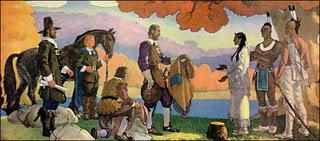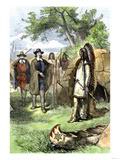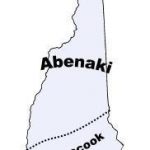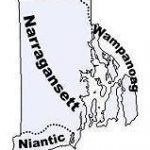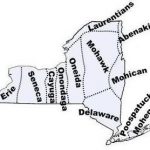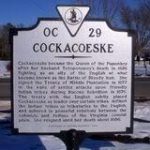Native American Leader
Image: Squaw Sachem Sells Her Land to John Winthrop, from a mural painting by Aiden L. Ripley, 1924
When the first English colonists arrived in the Boston area, the only inhabitants of the region were members of the Massachuset tribe. The Massachuset occupied valleys of the Charles and Neponset Rivers in eastern Massachusetts, including the present site of Arlington, which the natives called Menotomy, meaning place of swiftly running water. The name Massachuset means those of the great hills, probably with reference to the ring of hills surrounding the Boston Basin.
In 1614, when Captain John Smith explored the coast of New England, there may have been as many as 3,000 Massachuset living in 20 villages around Boston Bay. They were divided into six sub-tribes named after their chiefs or sachems. Between 1614 and 1617, disaster struck in the form of three separate epidemics of European diseases. During the same period, the Abenaki tribe from the north attacked the Massachuset villages.
Squaw Sachem
The hereditary chief of the sub-tribe that occupied Menotomy was a woman whose full name is unknown. Her husband was Nanapeshemet (New Moon), one of the greatest sachems in New England, ruling over a larger area than any other. She married him sometime between 1600 and 1608, when her first son was born. They had three sons and a daughter during the next ten years.
When Nanapashemet’s enemies began their relentless assault on the coastal villages of Massachuset Federation territory, Nanapashemet sent his wife and four children inland for protection. After Nanaspashemet’s death, his wife and children came out of hiding, and she took over his former domain.
It was a customary sign of respect for the Massachuset to avoid speaking the real name of their sachems. They referred to them only by their titles. It was because of that respect that we know Nanapashemet’s wife only by her title, Squaw Sachem. In the Eastern Algonquian language of the Massachuset her name translates simply as female chief.
Squaw Sachem and her young children must have come home to a horrible sight. Not only had they lost their beloved husband and father, but entire villages of their people had been wiped out by a devastating plague. Those who survived were ravaged by war. Where five years earlier an entire culture of people thrived in magnificent numbers, there was only desolation. Only 500 Massachuset were left in the immediate area, and smallpox killed many of these in 1633.
But Squaw Sachem pressed on. Her territory extended from Charlestown to Concord and up to Marblehead, and she ruled over the Massachuset Federation of Tribes. She rose to prominence as the most important Massachuset leader of her era.
Plymouth colony settlers moving westward among the Massachuset at Wessagusset established the first English settlement in the area in 1622. These and other early settlers established close relations with influential Massachuset leaders like Squaw Sachem.
She extended her authority through her sons. One of her sons, Wonohaquaham, known to the English as Sagamore John, headed a Massachuset community on the Mystic River. Two others, Montowampate, called Sagamore James by the English, and Wenepoykin or Sagamore George, were chiefs of Pawtucket communities at Saugus and Salem.
Sometime in the 1620s, Squaw Sachem married Webcowit, the great physician of her nation, but retained her power. She conducted raids against tribes that tried to encroach on her territory. These raids ceased after 1625, because her tribe was then too small for such aggressive action.
To survive, she had to establish a friendly relationship with the English colonists. Her oldest son gave the English the right to settle in the area of Charlestown along the Charles River in 1627. He died a few years later from smallpox, as did one of her other sons, and the youngest was badly disfigured.
Mistick Land
In 1639, Squaw Sachem and Webcowit signed over to the English a large tract of land “within the bounds of Watertown Cambridge and Boston.” She marked the treaty with the symbol of a bow and arrow. This is the text of the agreement by which she sold Menotomy and adjacent land to the colonists:
The 15th of the 2d month, 1639.
We Webcowit and Squaw Sachem do sell unto the Inhabitants of the Towne of Charlestown, all the land within the line granted them by the court, (excepting the farms and the ground, on the west of the two great Ponds called Mistick ponds, from the south side of Mr. Nowell’s lot, near the upper end of the Ponds, unto the little runnet that cometh from Capt. Cook’s mills, which the Squaw reserveth to their use, for her life, for the Indians to plant and hunt upon, and the weare above the ponds, they also reserve for the Indians to fish at whilest the Squaw liveth, and after the death of Squaw Sachem, she doth leave all her lands from Mr. Mayhue’s house to near Salem to the present Governor, Mr. John Winthrop, Senior, Mr. Increase Nowell, Mr. John Wilson, Mr. Edward Gibbons to dispose of, and all Indians to depart, and for satisfaction from Charlestown, we acknowledge to have received in full satisfaction, twenty and one coats, nineteen fathom of wampum, and three bushels of corn.
In witness whereof we have here unto set our hands the day and year above named,
the mark of Squaw Sachem, the mark of Webcowit.
There are records of several other sales of land by the Squaw Sachem and Webcowit to the English settlers. In addition to the proceeds from such sales, they received help and goods from the settlers.
In May 1640, Cambridge was ordered to give the Squaw Sachem a coat every winter for life. On September 4, 1640, she sold Mistick Ponds and a large tract of land now included in Sommerville, to Jotham Gibbons, of Boston, at that time she called herself Squaw Sachem of Mistick.
In 1641, Cambridge was enjoined to give her 35 bushels of corn and four coats (for two years). In 1643, the court granted her gunpowder and shot and ordered “her piece to be mended.” In 1644, she signed a treaty of submission to the English, agreeing to place her land and people under the control of the Massachusetts Bay Colony, and consented to have her subjects instructed in the Bible.
She lost her sight and hearing in 1662, and had a stroke that completely paralyzed her in 1667, the year of her death.
Squaw Sachem of Mistick died circa 1667. She was buried in what is now Medford, the exact location unknown.
No organized groups of the Massachuset are known to have survived after 1800.
SOURCE
Squaw Sachem
